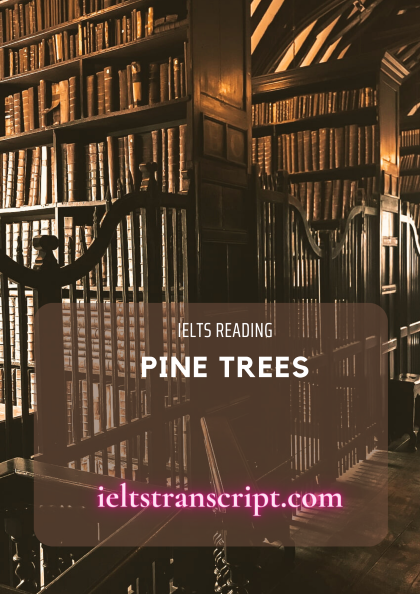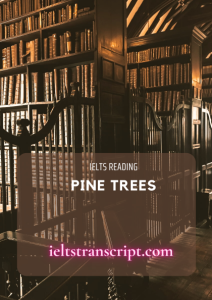- Đối với sản phẩm có giá: Sau khi chúng tôi ghi nhận thông tin đã thanh toán sản phẩm của bạn, sản phẩm sẽ được mở khóa và bạn có thể xem trực tiếp và tải tài liệu sản phẩm.
- Đối với thành viên trả phí: Bạn có thể mua và thanh toán sản phẩm với giá 0đ để tải tài liệu sản phẩm.
- Bạn có thể liên hệ với chúng tôi để được hỗ trợ mở khóa sản phẩm sớm nhất.
PINE TREES
- Chúng tôi chấp nhận các phương thức thanh toán sau đây: Thẻ tín dụng, thẻ ghi nợ, PayPal, chuyển khoản ngân hàng và tiền mặt.
Chúng tôi sẽ không thu thêm phí cho bất kỳ hình thức thanh toán nào.
- Nếu bạn gặp vấn đề về sản phẩm của chúng tôi trong thời gian sử dụng, vui lòng liên hệ với chúng tôi để được hỗ trợ xử lý sớm nhất nhé.
Xem trước mẫu
Pine Trees
I am looking at a very thick twisted trunk, rising to medium height, at which point appears a stumpy canopy of spiky needles. It’s a tree, but a very special one. Ron Simonson, a park ranger explains. “It’s a bristlecone pine, and it’s been given the name, Methuselah”. I ask the obvious question, and Ron replies, “Because like Methuselah from the bible, this tree is very old, one of the oldest living things on Earth in fact.” I ask the next obvious question, and Ron replies, “Basically Methuselah has existed throughout virtually all of recorded human history.” I look again at this quiet and unassuming tree, beginning to realise it is worthy of great respect.
Being in a cold climate, facing limited summer seasons, rooted in nutrient poor and dry soil, and subject to high winds and withering winters, bristlecone pines mature very slowly indeed. Yet mature they do, as with all pines becoming fractionally thicker every year as another growth ring is added to their truck. By counting these, we can accurately state that, as of 2011, Methuselah was4,842 years old, meaning that it sprouted as a seedling in 2832 BC, centuries before the ancient Egyptians began building their pyramids. And that’s just one fascinating fact about that well-known species of tree – the pine.
Pines trees are native to most of the Northern Hemisphere. Several species have adapted to the harsh conditions of high elevations and latitudes, including Methuselah himself, growing among the peaks of the White Mountains of Northern California.
Pines can be small, such as the Siberian Dwarf Pine, or huge, such as the Ponderosa Pine in the wilds of Oregon, and there are over 100 varieties in all. They have been introduced in to the more temperate portions of the Southern Hemisphere, where they are now grown widely, becoming a familiar feature in parks and gardens. It would not be too much of an exaggeration to say that almost everyone knows pines.
These trees certainly have many telltale characteristics. They are evergreen, usually with needle-like foliage and a sharp pleasant ‘pine smell. They are often large and imposing, with thick scaly bark, and always produce their signature pine cones. These formations are certainly not simple. They can be male (small, inconspicuous, and shedding pollen) or female (large, woody, and containing seeds), even when appearing on the same tree. They have numerous scales arranged in a spiral, with seeds (on the female) tucked within. As the cone opens, the seeds eventually fall out, mostly to be dispersed by the wind, or sometimes by birds. In some varieties, the cones remain closed until their binding resin is melted by forest fires.
This last fact – the need for wildfires for regeneration – is another fascinating aspect of many pine species. In fire-prone areas, it can result in extensive stands of pines, a good example being in ‘pine barrens’. These are eco-regions of sandy nutrient-poor soil dominated by pines, since the frequency of natural (usually lightning-induced) fires weeds out the less fire-tolerant species. It is perhaps sad that modern fire prevention methods have resulted in the decline of many pine species in the wild, and most ancient pine barrens are now being taken over by other forest vegetation.
However, the situation is very different for home and commercial use, which has seen pines become a very common sight. As these trees grow fast, can be planted in dense arrays, and produce attractive and easily moulded wood, they are favourites for commercial plantations. The wood is fragrant, but prone to decay, so it is most suitable for indoor or dry carpentry, rather than outdoors, where more durable varieties are necessary. As for other uses of pines, their branches are valued as Christmas trees, and their wood is also pulped in factories for paper and chipboard production. Pine resin is a byproduct, and this is collected for distillation into turpentine, an important industrial solvent.
In a more homely
...Những cây thông
Tôi đang nhìn một thân cây dạng xoắn rất dày, vươn cao vừa phải, một tán cây lá kim nhọn ló ra. Đó là một cái cây, nhưng là một cây rất đặc biệt. Ron Simonson, một nhân viên kiểm lâm công viên giải thích. “Đó là cây thông bristlecone, và nó được đặt tên là Methuselah”. Tôi hỏi một câu rõ ràng, và Ron trả lời, “Bởi vì giống như Methuselah trong kinh thánh, cây này rất cổ, thực tế là một trong những sinh vật sống lâu đời nhất trên Trái đất.” Tôi hỏi một câu rõ ràng `tiếp theo, và Ron trả lời, “Về cơ bản Methuselah đã tồn tại gần như xuyên suốt chiều dài lịch sử nhân loại được ghi lại.” Tôi lại nhìn vào cái cây tĩnh lặng và khiêm nhường này, bắt đầu nhận ra nó đáng được trân trọng biết bao.
Sống ở khí hậu lạnh, đối mặt với mùa hè ngắn ngủi, mọc trên đất khô, nghèo dinh dưỡng và chịu nhiều gió lớn và mùa đông khô héo, cây thông bristlecone thực sự phát triển rất chậm. Tuy nhiên, chúng vẫn trưởng thành, giống như tất cả các cây thông đều trở nên dày hơn một chút mỗi năm khi một vòng tăng trưởng khác được thêm vào thân của chúng. Bằng cách đếm những vòng này, chúng ta có thể phát biểu chính xác rằng, tính đến năm 2011, Methuselah đã 4.842 tuổi, có nghĩa là nó đã nảy mầm lên một cây con vào năm 2832 trước Công nguyên, nhiều thế kỷ trước khi người Ai Cập cổ đại bắt đầu xây dựng kim tự tháp của họ. Và đó chỉ là một sự thật thú vị về loài cây nổi tiếng – cây thông.
Cây thông có nguồn gốc từ hầu hết Bắc bán cầu. Một số loài đã thích nghi được với điều kiện khắc nghiệt của địa hình núi cao và vĩ độ cao, bao gồm cả Methuselah, phát triển ở các đỉnh núi của dãy White Mountains, Bắc California.
Thông có thể nhỏ, chẳng hạn như Thông lùn Siberia, hoặc to lớn, chẳng hạn như Thông Ponderosa ở vùng hoang dã của Oregon, và có hơn 100 giống tất cả. Chúng đã được đưa đến các khu vực ôn đới hơn của Nam bán cầu, nơi chúng hiện được trồng rộng rãi, trở thành một đặc điểm quen thuộc trong các công viên và các khu vườn. Sẽ không quá lời khi nói rằng hầu như ai cũng biết cây thông.
Những cây này chắc chắn có nhiều đặc điểm để nói. Chúng luôn có màu xanh, thường có bộ lá hình kim và có thông có mùi hắc dễ chịu. Chúng thường to lớn và uy nghiêm, với lớp vỏ dày có vảy và luôn tạo ra những nón thông (quả thông) đặc trưng. Sự hình thành này chắc chắn không đơn giản. Chúng có thể là nón đực (nhỏ, khó thấy và rụng phấn) hoặc nón cái (lớn, thân gỗ và chứa hạt), ngay cả khi xuất hiện trên cùng một cây. Chúng có nhiều vảy xếp thành hình xoắn ốc, với các hạt (ở nón cái) được xếp gọn bên trong. Khi nón mở ra, hạt rơi ra, phần lớn sẽ bị phát tán nhờ gió, hoặc đôi khi nhờ chim. Ở một số giống, các nón vẫn đóng lại cho đến khi nhựa liên kết bị chảy do các vụ cháy rừng.
Sự thật cuối cùng – nhu cầu cháy rừng để tái sinh – là một khía cạnh hấp dẫn khác của nhiều loài thông. Ở những khu vực dễ xảy ra cháy rừng, có thể có nhiều cây thông mọc lên, một ví dụ điển hình là “rừng thông’. Đây là những vùng sinh thái có đất cát nghèo dinh dưỡng được bao phủ bởi những cây thông, vì tần suất cháy rừng tự nhiên (thường là do sét) đã loại bỏ các loài kém chịu lửa hơn. Có lẽ điều đáng buồn là các phương pháp phòng cháy hiện đại đã làm suy giảm nhiều loài thông trong tự nhiên, và hiện nay hầu hết các rừng thông cổ đang bị các thảm thực vật rừng khác xâm chiếm.
Tuy nhiên, tình hình sử dụng thông trong gia đình và thương mại lại rất khác, điều này đã khiến cây thông trở thành một hình ảnh phổ biến. Vì những cây này phát triển nhanh, có thể được trồng thành những hàng dày đặc, và sản xuất ra gỗ hấp dẫn với thị trường và dễ tạo dáng nên chúng được ưa chuộng trồng cho mục đích thương mại. Gỗ có mùi thơm, nhưng dễ bị mục nên thích hợp nhất cho các đồ mộc dùng trong nhà hoặc nơi khô ráo, hơn là để ngoài trời, nơi cần các loại gỗ bền hơn. Đối với các mục đích sử dụng khác, cành thông được dùng làm cây thông Noel, và gỗ của chúng cũng được các nhà máy giấy nghiền thành bột để sản xuất giấy và ván dăm. Nhựa thông là một sản phẩm phụ, và chất này được thu thập để chưng cất thành
...Để xem được đầy đủ nội dung và tải dữ liệu, bạn phải trở thành thành viên của chúng tôi và trả phí cho tài liệu (nếu có)












